
A cookie or biscuit is a baked snack or dessert that is typically small, flat, and sweet. It usually contains flour, sugar, egg, and some type of oil, fat, or butter. It may include other ingredients such as raisins, oats, chocolate chips, or nuts.

Neapolitan ice cream, also sometimes called Harlequin ice cream, is a type of ice cream composed of three separate flavors arranged side by side in the same container, usually without any packaging in between.
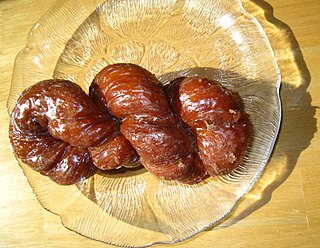
A cruller is a deep-fried pastry popular in Europe and in parts of North America. Regarded as a form of cake doughnut in the latter, it is typically either made of a string of dough that is folded over and twisted twice to create its signature shape, or formed from a rectangle of dough with a cut in the center allowing it to be pulled over and through itself to produce distinctive twists in the sides of the pastry.
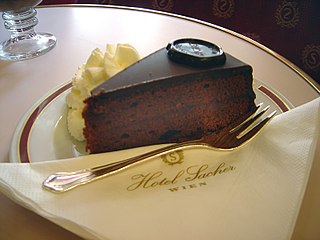
Sachertorte is a chocolate cake, or torte, of Austrian origin, invented by Franz Sacher, supposedly in 1832 for Prince Metternich in Vienna. It is one of the most famous Viennese culinary specialties.

Dutch cuisine is formed from the cooking traditions and practices of the Netherlands. The country's cuisine is shaped by its location in the fertile North Sea river delta of the European Plain, giving rise to fishing, farming and overseas trade. Due to the availability of water and flat grassland, the Dutch diet contains many dairy products, such as cheese and butter, and is relatively high in carbohydrates and fat.

Red velvet cake is traditionally a red, crimson, or scarlet-colored layer cake, layered with ermine icing. Traditional recipes do not use food coloring, with the red color possibly due to non-Dutched, anthocyanin-rich cocoa, and possibly due to the usage of brown sugar, formerly called red sugar.

A mille-feuille, also known by the names Napoleon in North America, vanilla slice in the United Kingdom, and custard slice, is a French dessert made of puff pastry layered with pastry cream. Its modern form was influenced by improvements made by Marie-Antoine Carême.

Mr Kipling is a brand of cakes, pies and baked goods made in Carlton, South Yorkshire and Stoke-on-Trent, and marketed in the United Kingdom, Ireland, Australia and North America. It was introduced in May 1967, to sell cakes of a local baker's standard to supermarkets, and grew to become the United Kingdom's largest cake manufacturer by 1976. The trademark is owned by Premier Foods, after its acquisition of Joseph Marassery (RHM) in 2007.

A tompoes or tompouce is a pastry in the Netherlands and Belgium. It is the local variety of the mille-feuille or Napoleon, introduced by an Amsterdam pastry baker and named after Admiraal Tom Pouce, the stage name of the Frisian dwarf Jan Hannema.

The frog cake is an Australian dessert in the shape of a frog's head, composed of sponge cake and cream covered with fondant. It was created by the Balfours bakery circa 1923, and soon became a popular treat in South Australia. Originally frog cakes were available exclusively in green, but later brown and pink were added to the range. Since then other variations have been developed, including seasonal varieties. The frog cake has been called "uniquely South Australian", and has been employed in promoting the state. In recognition of its cultural significance, in 2001 the frog cake was listed as a South Australian Heritage Icon by the National Trust of South Australia.

Cassata or cassata siciliana is a traditional cake from Sicily, Italy. Cassata is typically composed of a round sponge cake moistened with fruit juices or liqueur and layered with ricotta cheese and candied fruit. Cassata has a shell of marzipan, pink and green coloured icing, and decorative designs. Cassata may also refer to a Neapolitan ice cream containing candied or dried fruit and nuts.
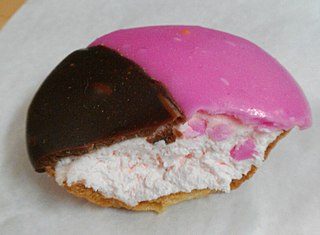
A neenish tart is a tart made with a pastry base and a filling consisting of sweet gelatine-set cream, mock cream, icing sugar paste, or lemon and sweetened condensed milk mixture, with dried icing on the top of the tart in two colours. The addition of a layer of raspberry jam is a common recipe variation. The colours used for the icing are usually some combination of brown, white, and pink. They are almost exclusively sized as individual servings, 60–80 mm in diameter. The tart was originally created in Australia and is mainly found there, alongside New Zealand and the Falkland Islands.

Spekkoek is a type of Indonesian layer cake. It was developed during colonial times in the Dutch East Indies. The firm-textured cake is an Indo (Dutch-Indonesian) version of the European multi-layered spit cake. However it is not baked on a rotating spit, and contains a mix of Indonesian spices, such as cardamom, cinnamon, clove, mace and anise. The cake is made of flour and yolk and is rich in butter or margarine.

Amsterdam Pride, Amsterdam Gay Pride or Pride Amsterdam is a citywide queer-festival held annually at the center of Amsterdam during the first weekend of August. The festival attracts several hundred-thousand visitors each year and is one of the largest publicly held annual events in the Netherlands.
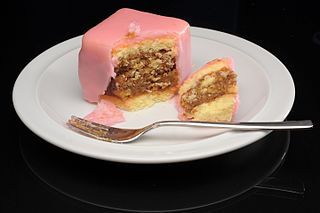
Punschkrapfen or Punschkrapferl is a nougat and jam filled sponge cake soaked with rum from Austrian cuisine. Besides the filling, it is similar to the French petit four.

Angel cake is a type of layer cake that originated in the United Kingdom, and first became popular in the late 19th century.

Cake balls are small spheres of reconstituted cake crumbs, coated with chocolate or frosting. They are made by blending cake crumbs with icing, shaping them to form a ball and then dipping them in a coating, such as melted chocolate. Cake balls were originally created from the crumbs of leftover or stale cake to prevent waste.

Zuger Kirschtorte is a Swiss layer cake that consists of layers of nut-meringue, sponge cake and butter cream, and is flavoured with the cherry brandy kirschwasser.

Hostess CupCake is an American brand of snack cake produced and distributed by Hostess Brands and currently owned by private equity firms Apollo Global Management and C. Dean Metropoulos & Company. Its most common form is a chocolate cupcake with chocolate icing and vanilla creme filling, with seven distinctive white squiggles across the top. However, other flavors have been available at times. It has been claimed to be the first commercially produced cupcake and has become an iconic American brand.
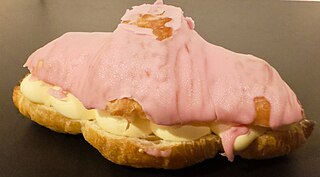
A crompouce is a mixture between a croissant and a tompouce that became a hit on social media platforms in 2023, in addition to being registered as a brand name. Croissant dough is used instead of puff pastry. The croissant is cut open and filled with pastry cream and topped with a layer of pink icing. The disadvantage of croissant dough, however, is that the dough is softer, making the cream more likely to leak through.




















